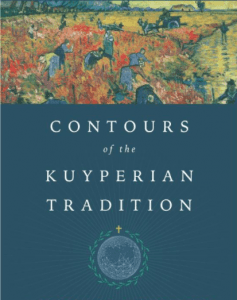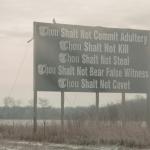 What is Kuyperianism? In much of the modern discussion (I hear) it has to do with two features: first, sphere sovereignty, by which Kuyper meant there are specific ways of indwelling various spheres of life that have their own sovereignty, and spheres are economics, education, church, politics, arts, etc. The second feature I often hear is about influencing the public sector by participation in various spheres.
What is Kuyperianism? In much of the modern discussion (I hear) it has to do with two features: first, sphere sovereignty, by which Kuyper meant there are specific ways of indwelling various spheres of life that have their own sovereignty, and spheres are economics, education, church, politics, arts, etc. The second feature I often hear is about influencing the public sector by participation in various spheres.
Accurate or not as precise as it could be, this is standard fare. Craig Bartholomew, in his new book , Contours of the Kuyperian Tradition, offers that nuanced view and we want to follow him into its depths in this series of posts.
I like where Bartholomew begins: the story of Kuyper and the fundamental importance of his conversion. This evangelical emphasis is not often heard in the above themes about Kuyperianism. Kuyper read a British novel and identified with one of the characters. It led to his conversion, in spite of his being reared in the home of a pastor. In fact, Kuyper had turned his back on the kind of faith found in his father. Until that novel.
This marks his turning from despair to hope, his finding his way home to God, and Kuyper notes, “I read that Philip knelt, and before I knew it, I was kneeling in front of my chair with folded hands. Oh, what my soul experienced at that moment I fully understood only later. Yet, from that moment on I despised what I used to admire and sought what I had dared to despise.”
It didn’t take long and Kuyper was on the prowl for modernism’s influence in the Reformed church and in the Netherlands. The following summary statement by Bartholomew deserves careful consideration: modernism is anti-Christianity. If that is the case, we are being swamped by it today. Anti-Christianity, then, is not so much postmodernity as it is a kind of modernity.
For Kuyper, as for Edmund Burke (1729-1797), modernism was the theory in which the polemic against Christianity has created its most coherent system.
He finds four characteristics:
What, Kuyper asks, is it in the spiritual atmosphere of the age that gave rise to modernism? He discerns four causes: first, the bankruptcy of contemporary philosophy; second, the impotence of revolution; third, the enormous expansion of the study of nature; and fourth, the somnolence of the church. Modernism, according to Kuyper, is a form of realism, but one well on the way to the abyss of materialism. Ironically, (theological) modernism arose to defend Christian faith against materialism.
We hear next a typical Reformed barb at modernity, one I learned first as a college student in Van Til and then in Schaeffer.
However, as regards faith modernism takes human authority and autonomy as its starting point, the precise thing Protestantism railed against.
Now, what about how to relate to society and culture? He sounds — if I may — a bit like Rod Dreher. Drop that and listen to this because it’s not one I often hear in Kuyperian proponents:
Instead Kuyper proposes we follow the example of God calling Abraham apart and of Christ forming the church by calling the Twelve apart to accompany him in his public ministry. He argues that those who retain faith and understand the danger of blurring the boundaries should begin by drawing a boundary around their own circle, by developing their own lives within that circle, so that they can mature to the point where they will be ready for the struggle that is at hand.
Withdraw; the church is an alternative; the church is a nation apart. His support?
Scripture is fundamental to Kuyper’s call for separation: “You are clear, then, on the purport of our system I am arguing for. A life-sphere of our own on the foundation of palingenesia [Greek for conversion, regeneration, renewal], and a life-view of our own thanks to the light that the Holy Spirit kindles on the candelabra of Scripture.”
Is this sectarian? Not for Kuyper (and neither is it for anabaptists if you read them carefully):
Notice that Kuyper’s call for separation is not in order never to reengage; rather, we separate so that we as Christians acquire the maturity needed for the struggle we must engage . This is withdrawal for mission, not withdrawal for the sake of withdrawal.
But Bartholomew is onto what I spoke of at the outset of this post. Kuyperians tend to have a theory of social action that neglects church:
At the same time, some converts to the Kuyperian tradition become so enamored with its public vision that they despair of and neglect the church.
We come now to the four elements of the Kuyperian tradition:
Conversion. (above)
Script ure. (above)
Palingenesis. By this Bartholomew sees a dual theme: personal and corporate/social.
He gets to the understanding of kingdom, one that I have my eyes on:
The kingdom is all about the reign of Israel’s God, about his climactic breaking into history in and through Jesus in order to recover his purposes for his whole creation. [Where’s the church here?] The rebirth of conversion thus involves becoming an active participant in the missio Dei: “Christianity aims at a new creation, but the new from the old, a new fashioned from the fallen world that already exists.”‘
Bartholomew will not let Kuyperianism be a theory of social engagement only. It’s redemptive, too.
Jesus, by comparison, asserts that we cannot see or enter the kingdom of God unless we are born again of the Spirit. The comprehensiveness of the kingdom is a major theme in the biblical and Kuyperian tradition, but it is vital that we not neglect the element of conversion in relation to it. [Agreed, and then this changes the meaning of kingdom to the redeemed. More on this later.]
The church. On this Kuyper was right and Bartholomew is right.
For now, we note that Kuyper never lost sight of the unique importance of the sphere of the institutional church. In his 1870 farewell sermon to his congregation in Utrecht, Kuyper was clear: “the problem of the church is none other than the problem of Christianity itself .”















